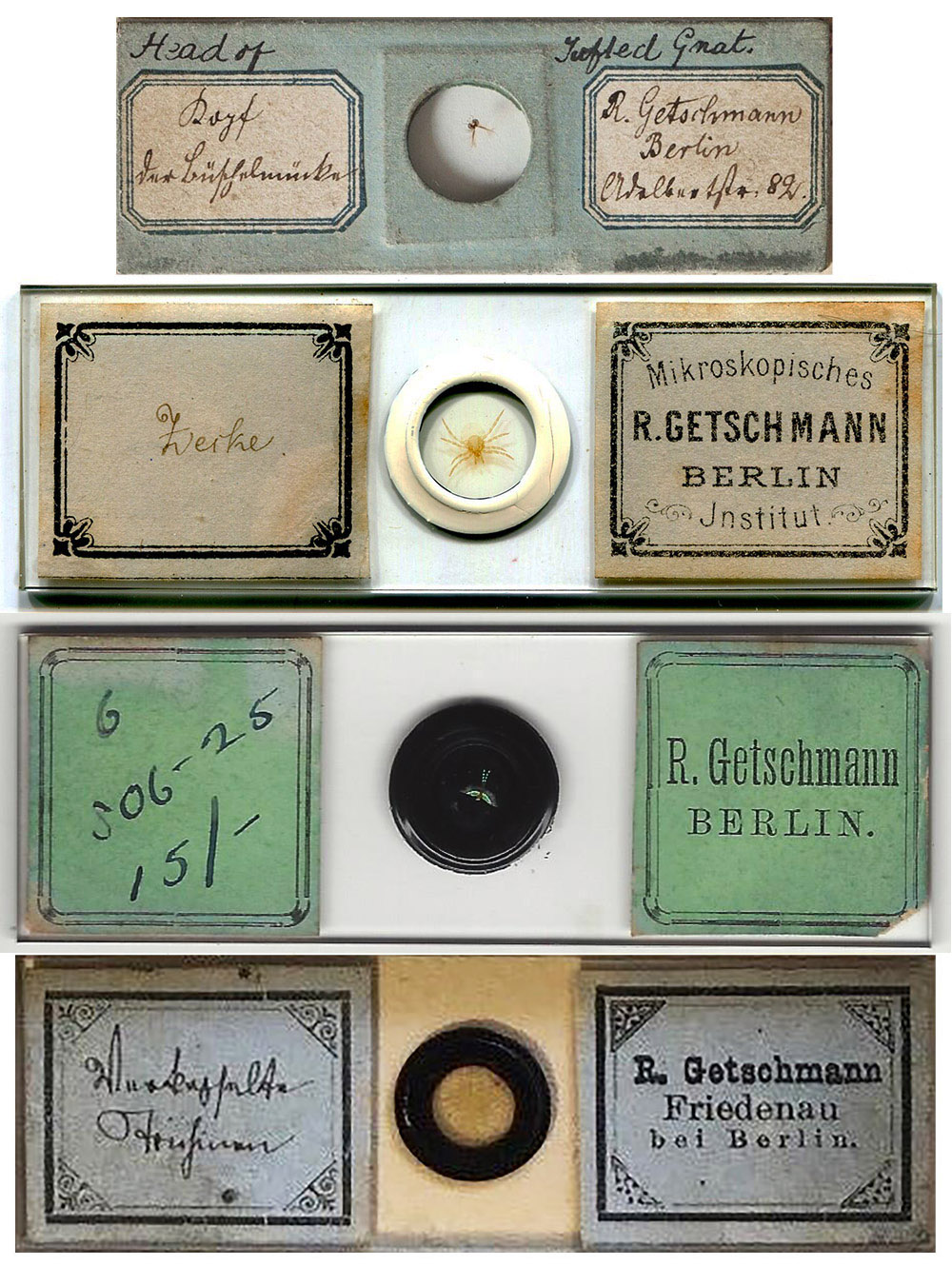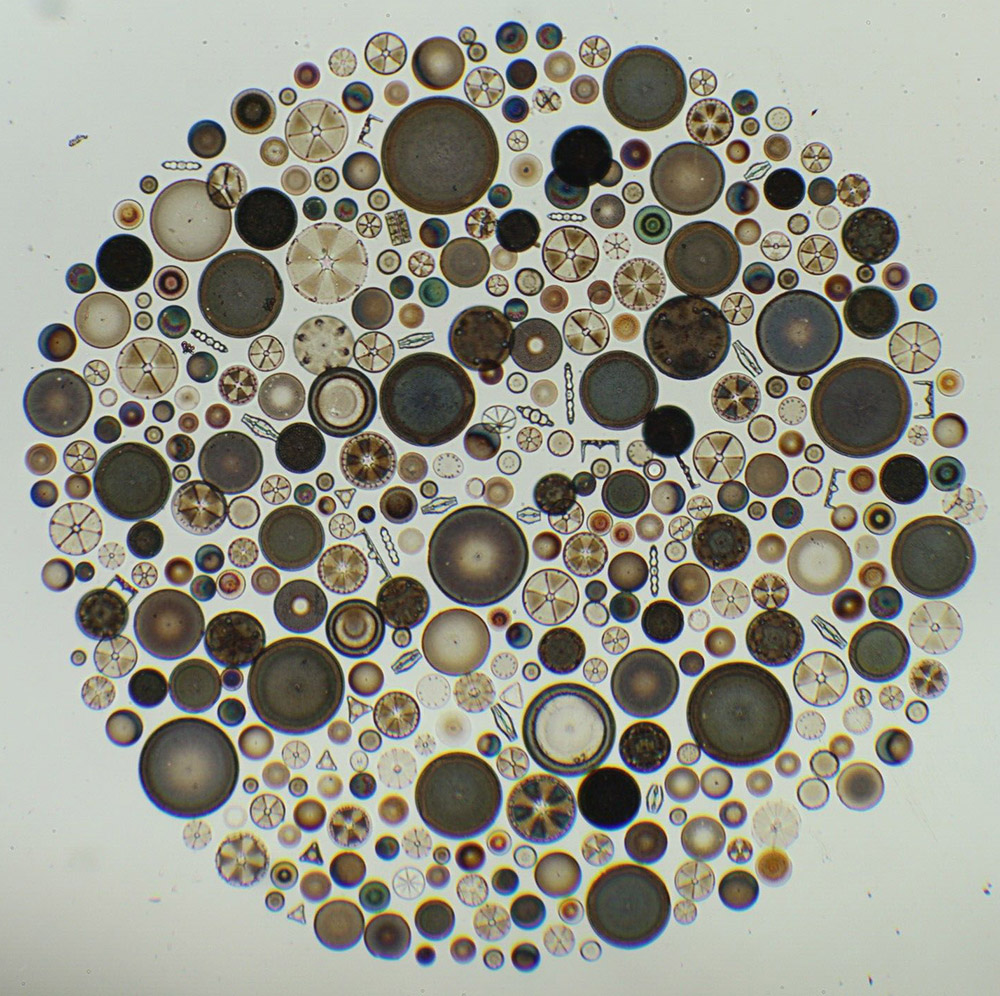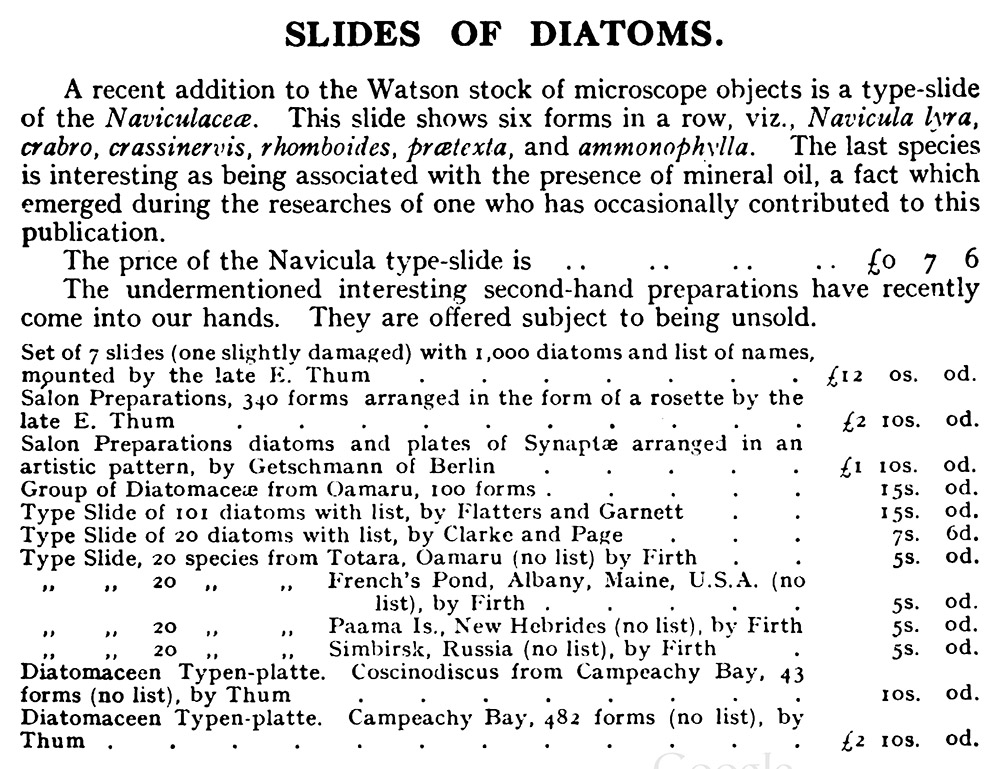Rudolf Getschmann, 1829 - 1911
by Brian Stevenson
last updated November, 2022
Rudolf Getschmann was a professional slide maker in and near Berlin, Germany. He mounted a wide variety of objects, but was best known for his artistic preparations of arranged diatoms, butterfly scales, sponge spicules, and other minute objects (Figures 1-3).
Getschmann began his business around 1876, and continued to prepare slides until his death in 1911.

Figure 1.
Microscope slides by Rudolf Getschmann.
(Top) A small slide with handwritten description and mounter’s information. The address is Adalbertstraße 82, Berlin, where Getschmann began his business in 1876, and operated until the early 1880s.
(Second down) A standard 1x3 inch slide, with printed label stating “R. Getschmann, Berlin, Mikroskopisches Institut”. He may have used such professional-looking labels during his later years at Adalbertstraße, and after his ca. 1885 move to Hermannstraße 179, in the Rixdorf area of Berlin.
(Third down) A different type of Getschmann label from Berlin.
(Bottom) Getschmann moved to Friedenau, near Berlin (bei Berlin) around 1899, and remained at that site until his death in 1911.
Images from the authors collection or used for nonprofit, educational purposes from internet sale sites.

Figure 2.
A microscopical bird that was made from butterfly scales by Rudolf Getschmann (see Figure 1, bottom). In his time, he was well known for his arrangements of butterfly scales, diatoms, etc. Adapted for nonprofit, educational purposes from an internet sale site.

Figure 3.
A Getschmann arrangement of diatoms. Adapted for nonprofit, educational purposes from an internet sale site.
According to Rudolf Getschmann’s January 2, 1911 death record, he was then 81 years. Another hand wrote “29-7-29” in pencil beside this, probably an indication that Getschmann was born on July 29, 1829. This record also states that Rudolf was born in Lublinitz (now Lubliniec, Poland).
Getschmann moved to Berlin around 1858, appearing in the Berliner Adreßbuch as a “Maler” (painter), living at 2 Hochstraße. The 1860 Adreßbuch described his occupation in greater detail, “Porzellan Maler” (porcelain painter). The 1875 and 1875 address books still listed his occupation as “Maler”, with a move to 82 Adalbertstraße.
The 1877 Berliner Adreßbuch, which would have been printed in late 1876, listed an occupational change for Getschamann, to “Berfertiger mikroskopischer Aprarate” (Maker of microscopic apparatus). This marked the beginning of his work as a professional microscopist.
By 1878, Getschmann was already producing microscope slides with arranged diatoms, scales, etc. In that year, Zeitschrift für Mikroskopie wrote, “Herr R. Getschmann sen., welcher als Präparator von Diatomaceen, Holothurien etc. sich bereits grösseren Ruf erworben hat, legte der Versammlung hierauf eine Collection von ihm gefertigter, besonders schön gelungener Einzelpräparate von Diatomaceen sowohl in Reihen, wie auch in Gruppen geordnet vor, welche den bekannten Möller'schen Typenplatten ebenbürtig zur Seite stehen. Als interessante mikroskopische Spielerei zeigte Herr Getschmann von ihm aus Schmetterlingsschuppen arrangirte Bouquets, Vögel etc. für Beleuchtung mit Oberlicht bestimmt , welche den allgemeinsten Beifall fanden”. (“Mr. R. Getschmann sen., who has already gained a good reputation as a preparator of diatomaceous plants, holothuria, etc., presented the assembly with a collection of particularly well-done individual preparations of diatomaceous plants that he had made, arranged both in rows and in groups, which compared to the well-known Möller's Type Plates stand by side on an equal footing. As an interesting microscopic gimmick, Herr Getschmann showed bouquets he had arranged from butterfly scales, birds, etc. intended for lighting with a toplight, which met with the most general applause.”).
In 1880, Otto Brandt, Fellow of the Royal Microscopical Society and Secretary of the Berlin Microscopical Society, exhibited before the R.M.S. “twelve slides by R. Getschmann, of Berlin (arranged Insect scales, &c.” and “slides of diatoms arranged by R. Getschmann”.
A writer for the Journal of the Royal Microscopical Society, who evidently was of the opinion that diatoms are best investigated in random strews, wrote, “Whether diatoms ought or ought not to be ‘arranged’ is a question which is more often answered in the negative, and in calling attention to the slides prepared by R. Getschmann of Berlin, we have no intention of objecting to the general verdict. We simply record the fact of the existence of the slides, and that they much surpass any of the previous efforts with which we are acquainted. With the diatoms are included Lepidoptera scales, Echinoderm spines, &c.”.
K.M. Cunningham, of Mobile, Alabama, USA, wrote to The Microscope in 1888 that he had “personally met, while in Europe last summer, a large number of prominent diatomists, and, in most cases, have been shown the methods of work peculiar to themselves. Among these noted preparers I may mention J. Kinker, of Amsterdam; Mr. Firth, and Joseph Wright, of Belfast; Carl Gunter, Rudolph Getschmann and Dr. Otto N. Witt, of Berlin; Edward Thum, of Leipzig; Eugen Weisflog, of Dresden; I.C. Rinnbock, of Vienna; Eugene Bourgone, Paris; Harold Dalton, Dr. Henry Stolterfoth, Chester, Eng.; Mr. Murray, in charge of the department of Micro-botany, of the British Museum, and H. Morland, of London”. Cunningham also described Rudolf Getschmann’s method of preparing arranged microscope slides, which is reproduced at the end of this history.
Getschmann also prepared materials in standard manners. In 1895, the United States’ Smithsonian Institute reported, "Diatomaceous earth has been received from Mr. R. Getschmann, Rixdorf, near Berlin, Germany, for which similar material has been returned”.
Getschmann moved to Friedenau, “bei Berlin”, between 1896 and 1899. He was still listed in the Berliner Adreßbuch in 1910 (Figure 4).
Rudolf Getschmann died in Friedenau on January 2, 1911.

Figure 4.
Listing of Rudolf Getschmann in the 1910 Berliner Adreßbuch.
______________________________________________________
Rudolf Getschmann’s mounting methods, as described by K.M. Cunningham, of Mobile, Alabama, in his paper, “On the preparation of type-plates, and arranged groups of diatoms”:
“While abroad, I secured a collection of the finer diatom preparations showing the skill of some of the parties already referred to. Herr Rudolf Getschmann, of Rixdorf, near Berlin, with whose preparations I am most familiar, proceeds in their preparation after the following method, which he demonstrated before me. A table is arranged before a well lighted window, and on this is placed the requisite appliances for work. The chief requisite being a small dissecting microscope, fitted with simple achromatic lenses, varying in their focal length as the case might require, but a lens of about a quarter-inch focus answering for actual work. Preparatory to beginning a selection of diatoms for the design to be arranged, a quantity of cleaned diatom material is evenly spread over an ordinary slide, this is carefully examined, and from it is selected all the perfect forms likely to be used in a design, and transferred to a cover-glass; all forms of the same shape being grouped together, or arranged in lines for convenience afterwards; if necessary, several cover-glasses can be thus filled with perfect forms, free from cracks or other blemishes, and placed aside, protected from dust until required. The diatoms are picked out from the spread layer of material, by the aid of hair bristles of varying degrees of fineness mounted in a slender wooden handle, and projecting therefrom about a half inch; the bristle should be straight, and, if possible, have a fine taper to a sharp point, this is handled, or used, with a free and steady hand, and, to facilitate steadiness in picking out, the two arms are rested upon two cushioned blocks of wood, tapering from the level of the stage of microscope to their bases on table. A further indispensable piece is a glass slide, having an area at its center of about a quarter of an inch, or somewhat less, ruled into minute squares, at the rate of about forty lines to the quarter inch; on this slide, and properly centered, must be placed the cover-glass upon which it is desired to produce the group. The cover-glass is prepared by spreading at its center a minute drop of liquid gelatine by means of a little brass spatula, and allow to dry. A number of cover-glasses, after having been carefully chosen and thoroughly cleaned, might be prepared and also set aside for use later. The clear and transparent gelatine should be filtered before use, by passing it through suitable filter-paper, so as to prevent all chance dirt from marring the mount. When ready to begin a group, fix the cover-glass centrally over the area of squares by means of three little touches of wax, and then also adjust, close to the same cover-glass, one of the cover-glasses containing the diatoms previously selected for the grouping; or, if necessary, two or more, according to the complexity of the proposed design. With the selecting bristle in the right hand, and the eye adjusted to the lens, bring the glass containing the selected diatoms into the field of view, then carefully select as a center, a perfect disc, say, a Coscinodiscus; now shift the gelatined cover-glass into view and deposit the disc at its center, and carefully adjust it so that its center shall seem to cover the intersection of a group of the small squares; around the disc, as a center, adjust a series of small circular forms, space them at equal distances from each other. Should it next be desired to introduce a series of navicular or slender forms they may be adjusted into position by lining them over the guide lines radiating from centre of disc, or through the diagonals of the squares; in this manner proceed until the design is completed.
When the grouping is finally inspected, it is permanently fixed to the gelatine layer by holding the slide on a level, under the mouth, and breathing on it very carefully a few times. This is perfectly reliable and more expeditious than breathing through rubber or glass tubes for the same purpose.
For the purpose of mounting it is well to have a quantity of cells finished on slides and kept on hand. The slides are centered on turn-table and shallow cells of black shellac; are built up to suit the diameter of the cover-glass to be mounted thereon. This cell is filled with a drop of Canada balsam pressed out of a metal tube. The cover-glass containing the arranged diatoms is now freely immersed in filtered spirits of turpentine and also flushed with it, so as to expel all air from the diatoms and to clean off all motes or particles that may have lodged upon it during or after preparation of the same. The cover-glass is then set upon its edge to drain off superfluous turpentine, and while it drains, gently soften the the shellac cell over a spirit lamp, pick up the cover-glass and gently lay it centrally over cell, and press firmly into contact with the cell; the slide is then set aside with the cell side down, and supported on a level, to obviate as much as possible the floating out of place of any of the forms, which are sometimes displaced while drying.
The procedure described above is essentially that followed by the leading preparers, with more or less slight variations as to finish of cells and media used in mounting.
For the arrangement of type-plates of diatoms, the guide-lines and squares ruled on the cover-glass carrier serves to easily allow the forms to be adjusted in lines and properly spaced with the same ease as in symmetrical grouping. When such beautiful results as I have seen are produced by simple and inexpensive means, it seems to be not worth while to attempt this class of work with compound microscopes with mechanical fingers and ruled guides set in eye-piece as seems to prevail in the United States.
In order that specimens of slides by Herr Getschmann may be appreciated, and at the same time answer the purposes or illustration, I add a plate sketched off-hand, showing two arrangements made by him. The sketches, however, convey but an imperfect idea of the beauty and perfection of the originals, from which the sketches were made.
I trust that this exposé may encourage those who are pursuing the grouping of diatoms, for either pleasure or profit, to a complete success, and that on this side we may have a few names celebrated for the fineness and perfection of their work.”

Figure 5.
Watson and Sons was selling Getschmann’s arranged diatom slides as late as 1927. From “Watson’s Microscope Record”.
Resources
Berliner Adreßbuch (numerous years) accessed through https://digital.zlb.de/viewer/berliner-adressbuecher/
Bracegirdle, Brian (1998) Microscopical Mounts and Mounters, Quekett Microscopical Club, London, page 46
Cunningham, K.M. (1888) On the preparation of type-plates and arranged groups of diatoms, The Microscope, Vol. 8, pages 237-241
Death record of Rudolf Getschmann (1911) accessed through ancestry.com
Journal of the Royal Microscopical Society (1880) Vol. 3, pages 736 and 1085
Journal of the Royal Microscopical Society (1884) Getschmann’s arranged diatoms, page 478
The Naturalists' Universal Directory (1896) “Getschmann, R., Hermannstr. 170, Rixdorf, near Berlin. Diatoms. C. Ex”, page 55, Cassino, Boston
Tageblatt der Versammlung Deutscher Naturforscher und Aerzte (1886) “Getschmann, Mathematiker, Rixdorf, Hermannstr.", 170, Vol. 59, page 176
United States National Museum Annual Report (1895) page 29
Watson's Microscope Record (1927) Issue 17, page 11
Zeitschrift für Mikroskopie (1878) page 85




